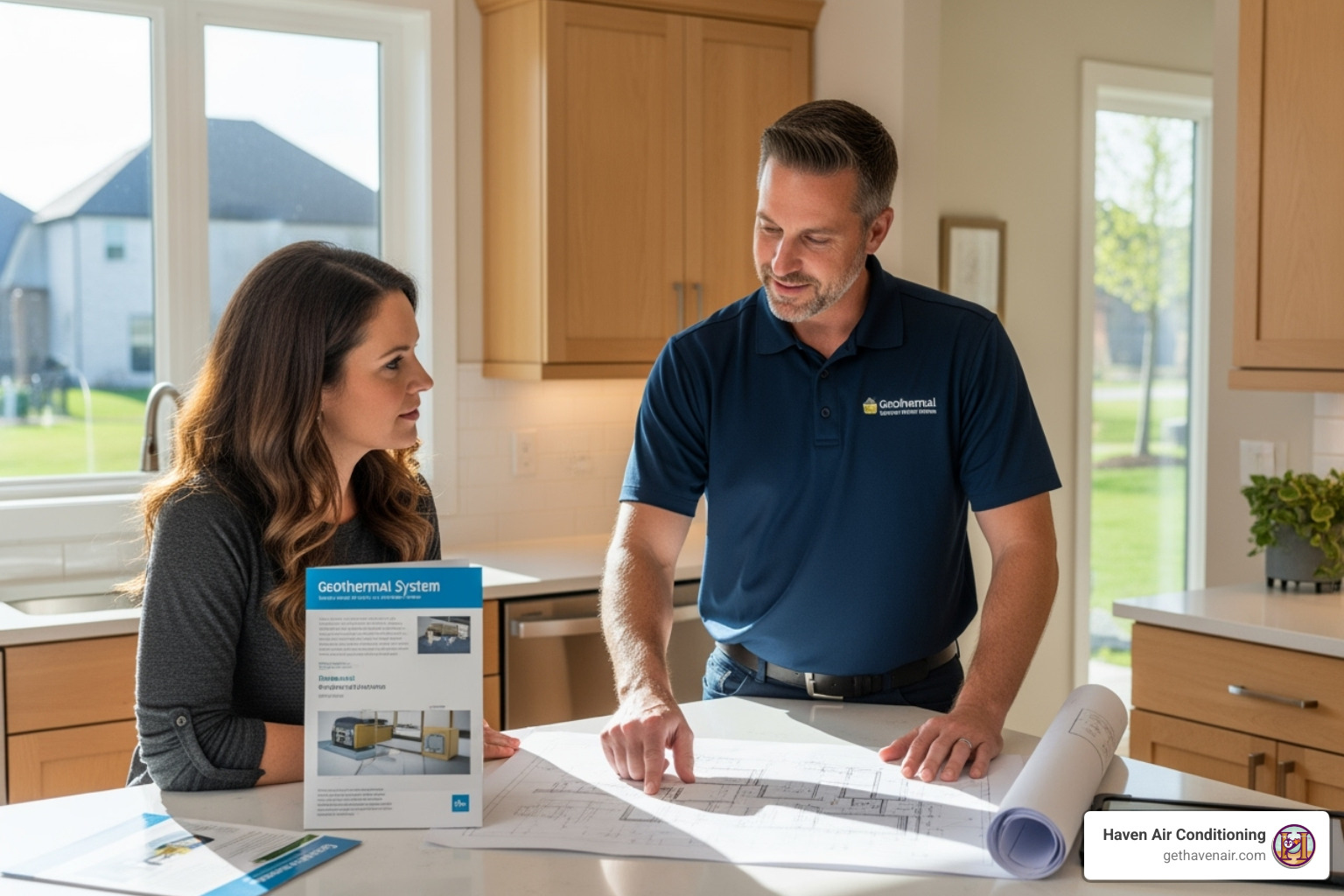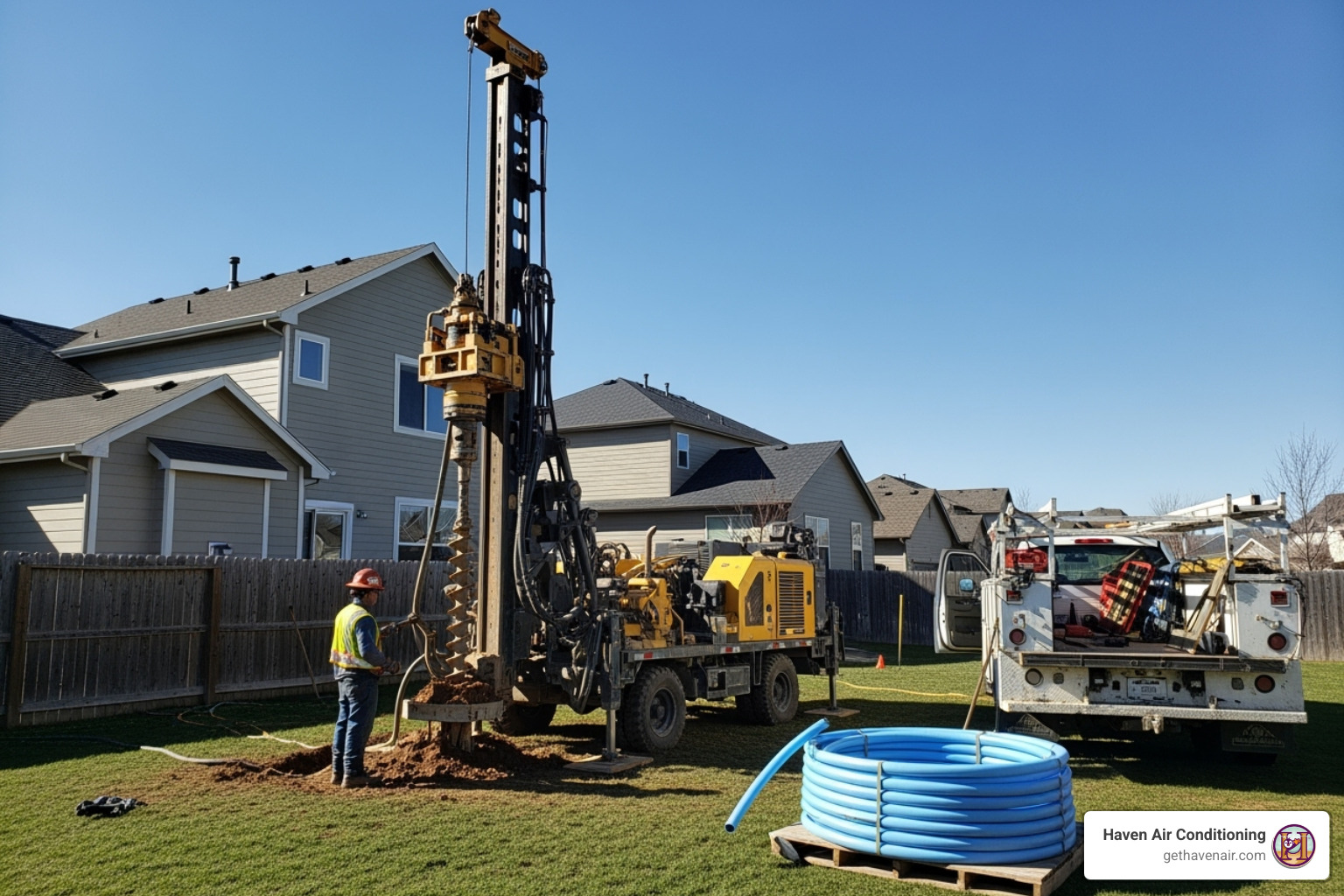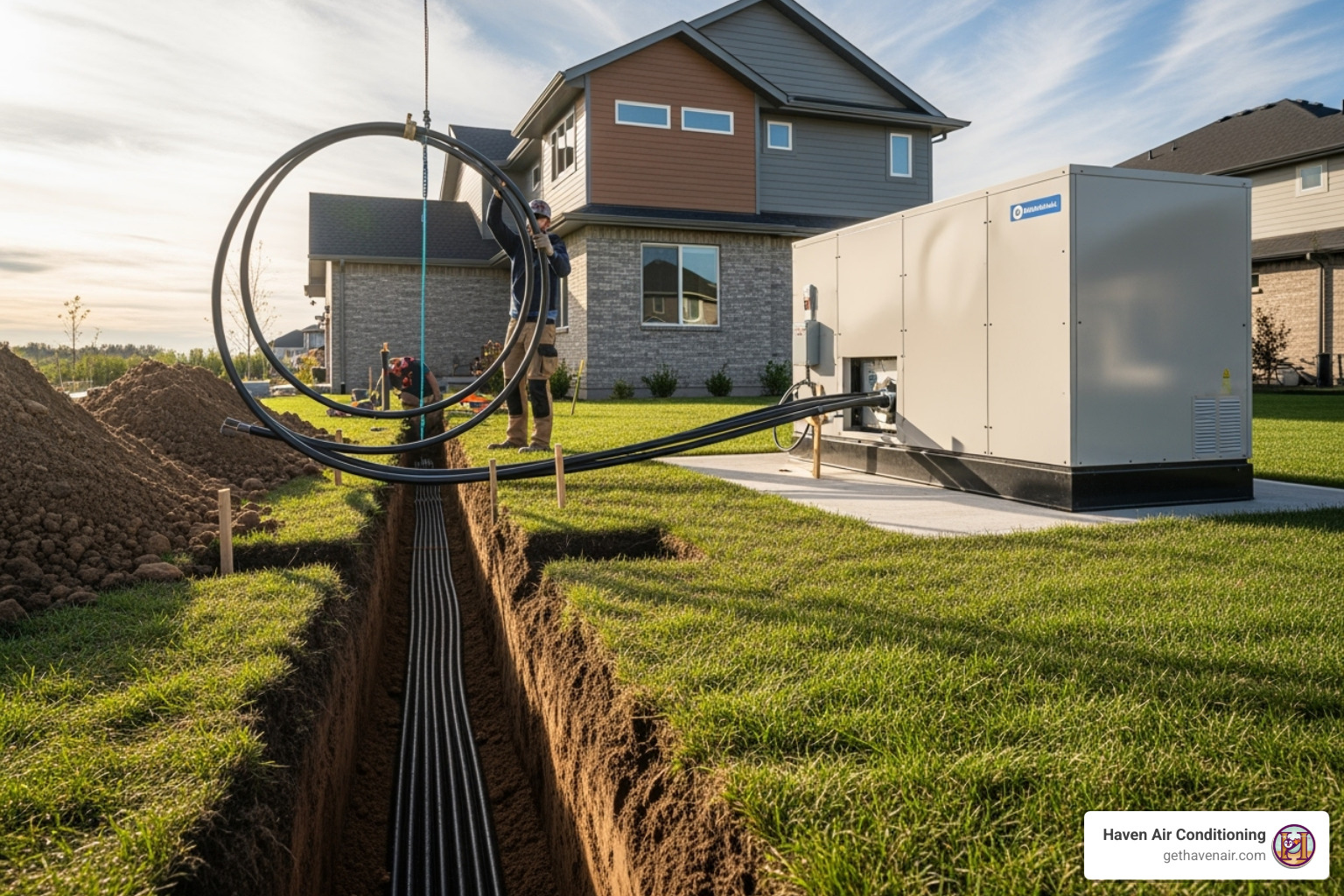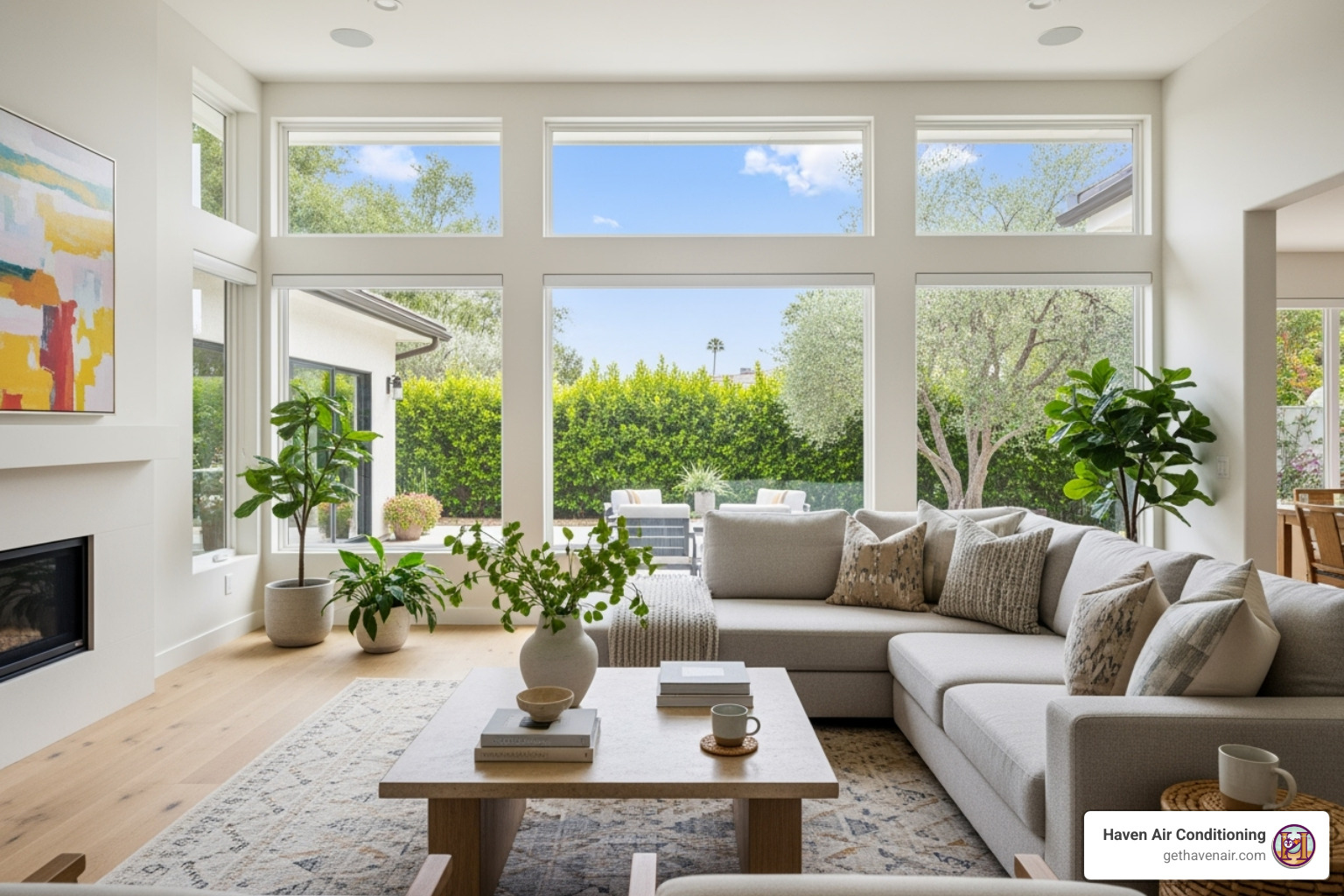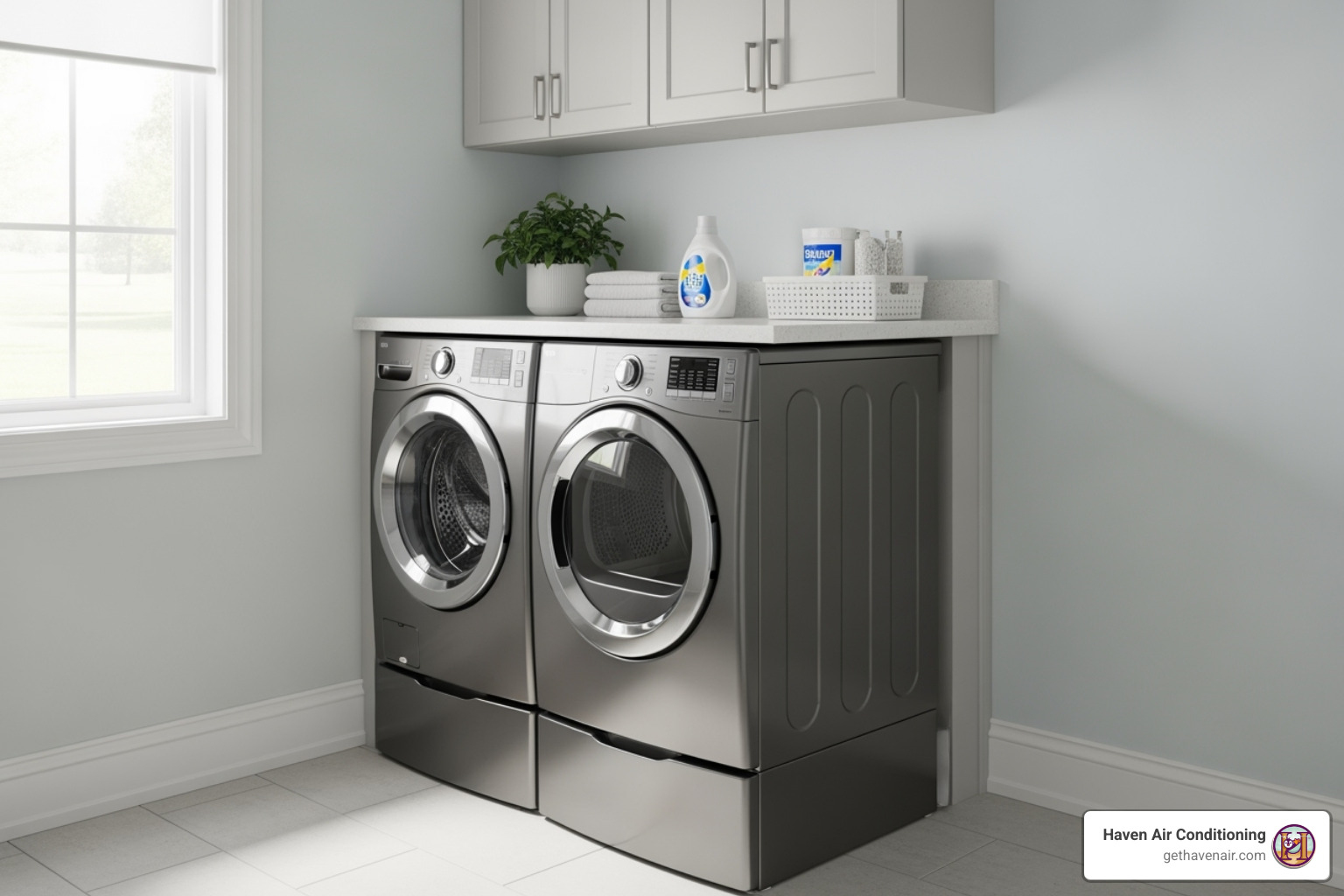Why Understanding Geothermal AC Costs Matters for Orange County Homeowners
The geothermal ac cost is a primary concern for Orange County homeowners considering this earth-powered technology. While the upfront investment is significantly larger than for conventional AC systems, that initial price doesn’t tell the whole story. The true cost includes the ground loop installation, system capacity, property characteristics, and the substantial long-term savings that can offset the expense.
Quick Cost Factors:
- System size and capacity: Based on your home’s square footage and energy needs.
- Loop system type: Horizontal, vertical, pond, or open-loop configurations.
- Installation complexity: Excavation, drilling, site access, and soil conditions.
- Equipment quality: Heat pump efficiency ratings and features.
- Labor and permits: Local contractor rates and regulatory requirements.
- Location factors: Climate, property size, and geology.
For homeowners considering residential HVAC upgrades, geothermal is a long-term investment in efficiency. Understanding the costs helps in making an informed decision. Schedule a consultation with Haven Air Conditioning to see if geothermal is right for your Orange County home.
Understanding the Initial Investment: What Factors Influence Geothermal AC Cost?
Unlike a traditional air conditioner, the geothermal ac cost includes a significant underground component that taps into the Earth’s constant temperature. This is an energy infrastructure for your home, not just an appliance. The investment covers the ground loop installation, drilling or excavation, and the expertise to design a system matched to your property.
Key factors influencing the final investment include:
- System Capacity: Measured in tons (12,000 BTUs/ton), it’s based on precise calculations of your home’s needs.
- Home & Property Size: Larger homes need bigger systems, and property size dictates the type of loop system possible.
- Climate & Geology: Orange County’s mild climate is ideal, but local temperature patterns and soil composition (sandy, clay, rocky) affect design and installation difficulty.
- Labor: Geothermal installation requires certified professionals with specialized skills in both HVAC and earthwork. For more on professional solutions, see our Residential HVAC page.
The Role of Home Size and System Capacity
Your home’s square footage is just the starting point. A thorough energy audit is crucial, examining insulation, window efficiency, and air sealing. A well-insulated home may need a smaller system than a leaky one of the same size.
Proper sizing calculations are critical to the geothermal ac cost. An oversized system costs more and runs inefficiently, while an undersized one struggles to maintain comfort. Professional technicians use detailed load calculations to determine the precise capacity your home needs, ensuring you don’t overpay and still get year-round comfort.
How Loop Systems Drive the Price
The ground loop system is a major cost factor. The type of loop depends on your property, and each has different cost implications.
| Loop Type | Relative Cost (Installation) | Space Required | Best Use Case |
|---|---|---|---|
| Horizontal | Generally Lower | Large (hundreds of feet) | Properties with ample land and suitable soil for trenching. |
| Vertical | Higher | Small (minimal surface area) | Urban lots, limited space, or rocky terrain requiring deep drilling. |
| Pond/Lake | Moderate | Access to a body of water | Properties adjacent to a suitable pond or lake. |
| Open-Loop | Often Lower | Access to groundwater | Properties with abundant, clean groundwater and proper disposal. |
- Horizontal loops involve trenching across a large area. The excavation is straightforward and more affordable but requires significant yard space.
- Vertical loops involve drilling deep boreholes, making them ideal for smaller lots or rocky terrain. The specialized equipment makes this option more expensive but leaves most of the yard untouched.
Site accessibility and geological conditions also impact the budget. Difficult access for equipment or hitting bedrock during excavation can increase labor and complexity. Your installer will account for these factors in the system design.
Breaking Down the Installation: A Look at Where Your Money Goes
Understanding where your investment goes helps explain the geothermal AC cost. A geothermal installation is a multi-faceted project with several key cost components.
- Ground Loop Installation: This is typically the largest expense, involving excavation or drilling to place the pipe network in the earth.
- Heat Pump Unit: This is the indoor component that moves heat. These units are engineered for high efficiency and longevity.
- Labor Expenses: This covers the skilled professionals who design, install, and commission the system, from drillers to HVAC technicians. For more on what professional work entails, see our guide on Installation.
- Ductwork Modification: Your existing ductwork may need adjustments to ensure optimal airflow for the new system.
- Permits and Fees: These ensure the installation meets Orange County’s building codes and safety standards.
Horizontal vs. Vertical Loop Installation Costs
As mentioned, the loop type significantly impacts your budget. Horizontal loops are generally more economical due to simpler excavation but require a large, open land area. This is a good option for Orange County homeowners with spacious yards.
Vertical loops are ideal for smaller lots or properties where you want to minimize landscape disruption. The process involves drilling deep boreholes, which requires specialized equipment and expertise, leading to a higher installation cost. However, they take up minimal surface area and are effective in rocky terrain.
Open-Loop and Pond Loop Systems
If your property has access to a sufficient water source, you may have other cost-effective options.
- Open-loop systems use groundwater from a well. The system draws water, exchanges heat, and returns it to the ground. This can be simpler and more affordable than installing a closed-loop system, but it requires a reliable source of clean groundwater and compliance with local water use regulations. Water quality testing is essential.
- Pond loop systems submerge coils of pipe in a nearby pond or lake. This avoids major excavation, making installation straightforward. The pond must be large and deep enough to provide stable temperatures year-round.
Both options require careful vetting to ensure they meet your property’s conditions and local regulations.
The Long-Term Value: Operational Costs, Savings, and Payback
While the initial geothermal AC cost is high, the long-term financial picture is where these systems excel. By using the Earth’s stable underground temperature, geothermal heat pumps operate with remarkable efficiency, leading to significantly lower operational costs.
Operational costs are limited to the electricity powering the compressor and pumps. This efficiency translates into lower utility bills. The U.S. Department of Energy states that geothermal systems can reduce heating costs by up to 50% and cooling costs by up to 35% compared to conventional systems. These savings accumulate year after year, creating a strong return on investment (ROI). Combined with a long lifespan, you also avoid the repeated replacement costs of traditional systems. For more on upgrading, see our information on HVAC System Upgrade.
Calculating Your Payback Period
The payback period is the time it takes for your energy savings to equal the initial installation cost. While the upfront geothermal ac cost is higher, monthly savings eventually lead to a break-even point.
Your payback timeline depends on:
- Initial Investment: The total cost of the system and installation.
- Annual Energy Savings: The difference in utility bills compared to a traditional system.
- Incentive Impact: Federal tax credits and local rebates can dramatically reduce your net investment and shorten the payback period, which often falls between 5 and 10 years. After this point, the system generates pure savings for decades.
Lifespan and Maintenance Costs
Geothermal systems are built for durability, which improves their long-term value and lowers the effective geothermal AC cost over time.
- Indoor Unit Lifespan: Typically 20-25 years, much longer than the 10-15 years for conventional furnaces and air conditioners.
- Ground Loop Durability: The underground pipes are incredibly robust, with a lifespan of 50 years or more. This part of the system is a permanent infrastructure for your property.
Annual maintenance is minimal. It usually involves checking the indoor unit, changing filters, and an annual professional inspection to ensure peak efficiency. With most components protected underground, there are fewer moving parts exposed to the elements, leading to less frequent repairs. For professional maintenance, our Heating Services page has more information.
Incentives, Drawbacks, and Final Considerations
A geothermal system is a major investment. While the long-term savings are impressive, it’s important to consider the financial help available and the potential challenges. Understanding the full picture of the geothermal ac cost helps you make a confident decision.
Financial incentives can significantly lower your initial cost. The federal tax credit offers a 30% credit for qualifying residential systems through 2032. Additionally, state and local rebates may be available. Check the Database of State Incentives for Renewables & Efficiency® for programs in your area. Some utilities also offer rebates or special financing. Our Financing Promotions page has more information on payment options.
Understanding the Disadvantages
Geothermal systems have tradeoffs. Be aware of these challenges:
- Initial Cost Barrier: The upfront geothermal ac cost is significantly higher than for conventional systems, even with incentives.
- Installation Complexity: Geothermal installation is a longer, more involved process requiring specialized contractors for excavation or drilling.
- Yard Disruption: The installation process, especially for horizontal loops, will temporarily disrupt your landscaping.
- Finding Qualified Installers: Not all HVAC contractors are certified for geothermal work. It’s crucial to find an experienced team, like the certified professionals at Haven Air Conditioning.
The Net Geothermal AC Cost After Incentives
The true geothermal ac cost is the price after incentives. The 30% federal tax credit, combined with state and local rebates, can dramatically reduce your out-of-pocket expense. These incentives make clean energy technologies more accessible and transform a large investment into a more realistic option for many homeowners. By doing your research and consulting with professionals, you can understand the real cost and long-term benefits for your Orange County home.
Frequently Asked Questions about Geothermal Systems
Here are answers to common questions Orange County homeowners have about geothermal systems.
How does the cost of a geothermal system compare to other high-efficiency HVAC options?
The upfront geothermal AC cost is higher than other high-efficiency options like conventional heat pumps or furnaces. However, the long-term financial picture is very different. Geothermal systems are far more energy-efficient, leading to savings of up to 50-65% on heating and cooling bills. Over time, these savings, combined with the system’s longer lifespan, often result in a better overall return on investment than any other HVAC option. For a comparison of different technologies, see our guide on Types of HVAC Systems.
Do you need a backup heat source with a geothermal system?
In Orange County’s mild climate, a properly sized geothermal system can handle most of your heating needs. However, for the rare, exceptionally cold nights, a supplemental heat source is often recommended to ensure year-round comfort. This is typically in the form of supplemental heat strips (electric resistance heaters) integrated into the indoor unit. This approach prevents the need to oversize the main system, which would unnecessarily increase the geothermal AC cost.
How long do the components of a geothermal system last?
Geothermal systems are known for their exceptional durability, which is a key part of their value.
- The indoor heat pump unit has a typical lifespan of 20-25 years, nearly double that of a conventional air conditioner or furnace.
- The underground ground loops are even more durable, with a lifespan of 50+ years. These pipes are protected from the elements and are essentially a permanent part of your property’s infrastructure.
This long-term durability means the high initial geothermal AC cost is a multi-generational investment, not just a short-term expense.
Is a Geothermal System the Right Investment for You?
Deciding on a geothermal system for your Orange County home means looking beyond the initial geothermal ac cost to the long-term value. These systems offer significant benefits:
- Financial Savings: Lower your heating and cooling bills by 25% to 65%, with savings that accumulate for decades.
- Durability: Indoor units last 20-25 years, and ground loops can function for over 50 years, reducing replacement costs.
- Environmental Impact: Tap into renewable energy, reduce your carbon footprint, and increase your home’s sustainability.
- Superior Comfort: Enjoy consistent temperatures, quiet operation, and improved indoor air quality.
While the high upfront investment and installation complexity are valid concerns, they are often offset by long-term savings. Federal tax credits of up to 30% (through 2032) and other local rebates can make the net cost much more manageable.
If you’re a homeowner in Anaheim, Santa Ana, or anywhere in the Greater Orange County Area, Haven Air Conditioning can help you determine if geothermal is right for you. Our certified professionals specialize in designing and installing the right solutions for your home and goals, with a commitment to exceptional service.
The question is whether you can afford to miss out on decades of savings and superior comfort. Request a professional heating installation consultation with Haven Air Conditioning today to explore if using the Earth’s energy is the right investment for your home.



